
Personal Finance and Money Management
You can meet this requirement with the following curricula:
Foundations in Personal Finance Fourth Edition: FL 2024 Version
Foundations in Personal Finance Honors Fourth Edition: FL 2024 Version
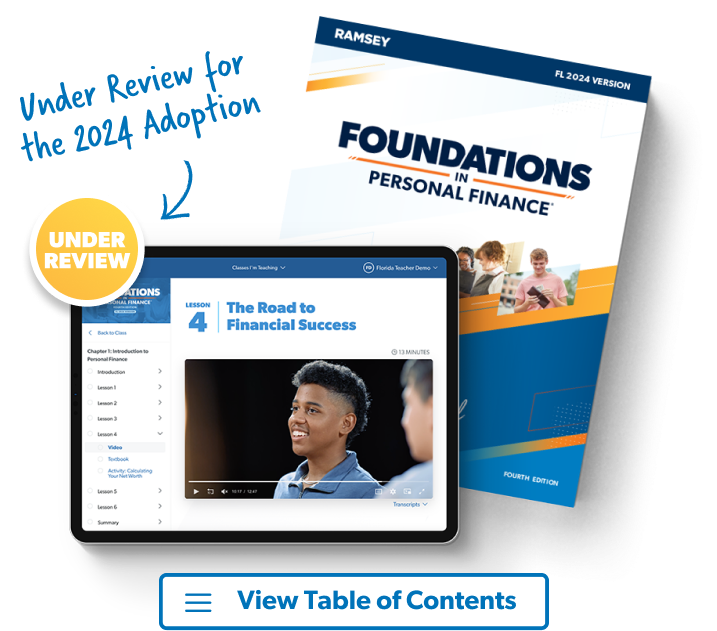

Economics and Personal Finance
You can meet this requirement with the following curricula:
Foundations in Economics and Personal Finance First Edition: FL 2024 Version
Foundations in Economics and Personal Finance Honors First Edition: FL 2024 Version
Foundations Aligns With Florida’s Resiliency Standards!
Ramsey Education is fully committed to Florida. That’s why we created custom content for Florida’s resiliency standards! These sections empower your students to overcome adversity by being adaptable and never giving up.
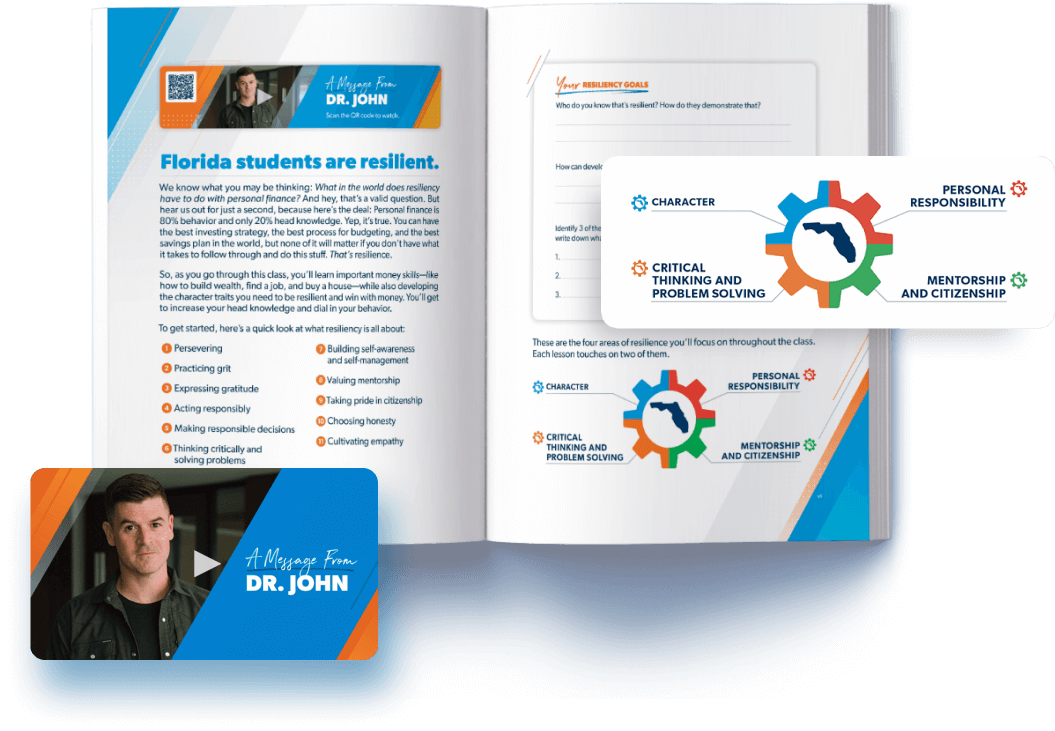
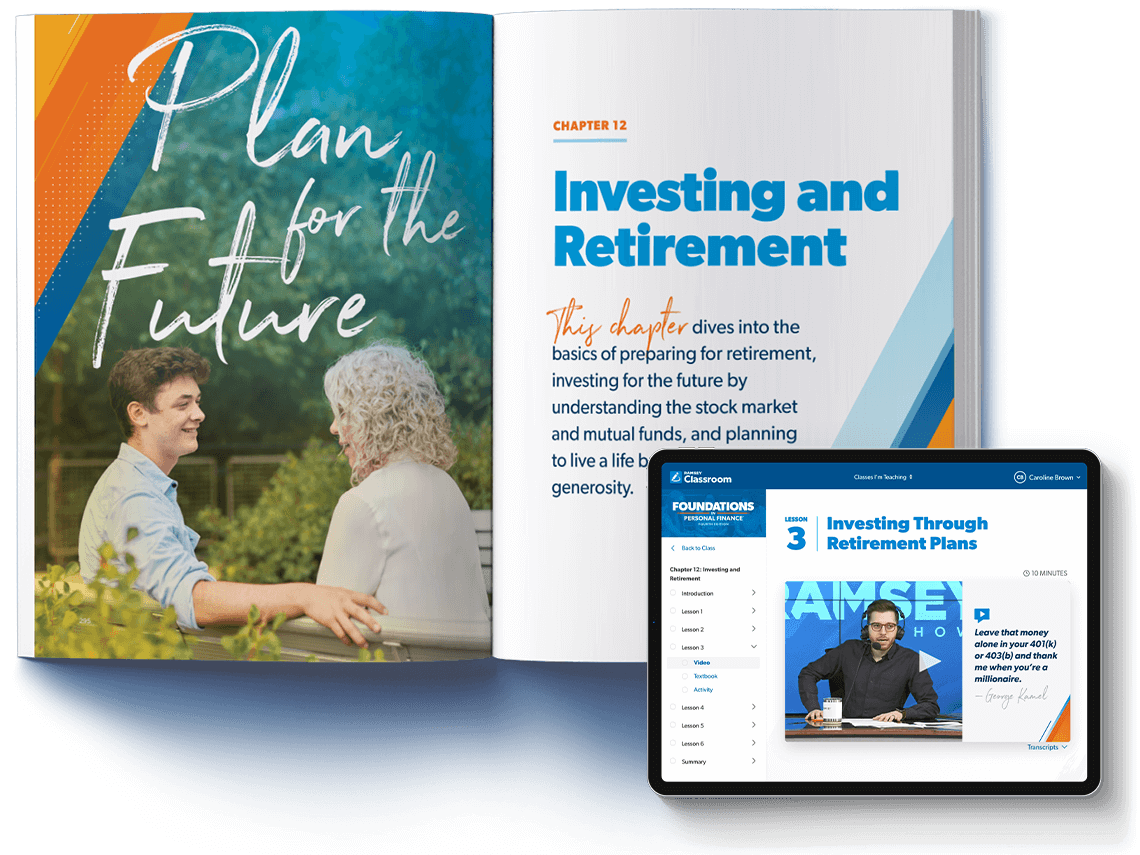
Features and Benefits
See why Foundations gives teachers so many advantages!

Delivery Options
Our course is compatible with:



Austin Smith
Account Executive
615.843.9461
austin.smith@ramseysolutions.com

Joseph Anderson
Account Executive
629.223.6445
joseph.anderson@ramseysolutions.com
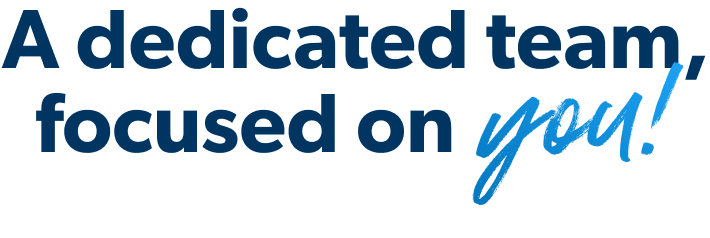

Austin Smith
Account Executive
615.843.9461
austin.smith@ramseysolutions.com

Joseph Anderson
Account Executive
629.223.6445
joseph.anderson@ramseysolutions.com
Table of Contents
The Foundations in Personal Finance high school curriculum consists of 13 chapters of essential personal finance principles like how to budget, save, avoid debt, invest, be a wise consumer and much more!
Personal Finance
-
Chapter 1: Introduction to Personal Finance
-
Introduces the topic of personal finance, explores the evolution of credit and consumerism in America, and highlights the importance of both knowledge and behavior when it comes to managing money.
- Lesson 1: Personal Finance and You
- Lesson 2: A History of Credit and Debt
- Lesson 3: It’s Time for a Change
- Lesson 4: The Road to Financial Success
- Lesson 5: Financial Literacy
- Lesson 6: Money Personalities and Relationships
-
Chapter 2: Budgeting Basics
-
Dives into why budgeting is key to taking control of money—and how students can get started right now.
- Lesson 1: The Benefits of Budgeting
- Lesson 2: Components of a Budget
- Lesson 3: Building a Zero-Based Budget
- Lesson 4: Tracking Your Expenses
- Lesson 5: Make Budgeting a Habit
- Lesson 6: Relationships and Budgeting
-
Chapter 3: Saving Money
-
Emphasizes the importance of saving and explains three reasons why students should save money: emergencies, large purchases, and wealth building.
- Lesson 1: Saving Money Takes Discipline
- Lesson 2: Three Basic Reasons to Save
- Lesson 3: Saving for Emergencies
- Lesson 4: Saving for Large Purchases
- Lesson 5: Building Wealth
- Lesson 6: Compound Interest and Growth
-
Chapter 4: Credit and Debt
-
Identifies the dangers of debt, debunks some credit myths, explains the credit report and score, and provides practical strategies to get out of debt—and stay out.
- Lesson 1: Beware of Credit and Debt
- Lesson 2: Sources and Types of Credit
- Lesson 3: Credit Scores and Credit Reports
- Lesson 4: The Truth About Credit Cards
- Lesson 5: The Truth About Car Loans
- Lesson 6: Getting and Staying Out of Debt
-
Chapter 5: Consumer Awareness
-
Highlights the importance of being a smart consumer as part of a healthy financial plan, explains strategies to manage spending behavior, exposes common consumer scams, and identifies consumer rights.
- Lesson 1: The Psychology of Sales
- Lesson 2: Buyer Beware
- Lesson 3: The Marketing Machine
- Lesson 4: Becoming a Smart Spender
- Lesson 5: Protecting Yourself as a Consumer
- Lesson 6: Your Spending Behavior
-
Chapter 6: Career Readiness
-
Examines how students can find the right career path and create strategies to land a job they’ll love so they can thrive and enjoy their work. They’ll also discover tips for building a resumé and presenting themselves well during a job interview.
- Lesson 1: Work Matters
- Lesson 2: Resumé and Interview Basics
- Lesson 3: An Entrepreneurial Mindset
- Lesson 4: The Path to Your Dream Job
- Lesson 5: Exploring Career Options
- Lesson 6: Be a Lifelong Learner
-
Chapter 7: College Planning
-
Explores the variety of educational options available after high school, highlights the dangers of student loans, and explains how students can pay cash for college and avoid student loan debt.
- Lesson 1: The Path to Intentionality
- Lesson 2: Explore Your Options
- Lesson 3: Consider the Cost
- Lesson 4: Reduce Your Cost
- Lesson 5: Build Your College Resume
- Lesson 6: Maximize Your Investment
-
Chapter 8: Financial Services
-
Explores the services provided by banks and credit unions, including the different options and features. Students will learn about responsible banking, how to manage their accounts, and the importance of keeping records.
- Lesson 1: The Purpose of Banks
- Lesson 2: Types of Financial Institutions
- Lesson 3: Your Bank Accounts
- Lesson 4: Responsible Banking
-
Chapter 9: The Role of Insurance
-
Breaks down the purpose of insurance, explains how insurance works, shows how insurance protects a person’s assets, and highlights the eight basic types of insurance everyone needs to have in place.
- Lesson 1: Insurance Is Important
- Lesson 2: Auto Insurance
- Lesson 3: Homeowners and Renters Insurance
- Lesson 4: Health Insurance
- Lesson 5: Life Insurance
- Lesson 6: Other Types of Insurances
-
Chapter 10: Income and Taxes
-
Digs into a huge reality in life: If someone earns an income, they’re going to pay taxes. This chapter also breaks down the basics of different types of taxes—like sales, excise, and federal taxes—including how they impact a person’s income and spending.
- Lesson 1: What Happened to My Money?
- Lesson 2: Taxes on Your Paycheck
- Lesson 3: Income Tax Basics
- Lesson 4: Filing Your Income Taxes
- Lesson 5: Taxes on Other Types of Income
- Lesson 6: Taxes on Things You Buy
-
Chapter 11: Housing and Real Estate
-
Identifies the differences between renting and homeownership. Students will discover the financial costs related to having their own place to live, and they’ll learn what to do when they’re ready to buy a house.
- Lesson 1: Living on Your Own
- Lesson 2: Renting vs. Owning
- Lesson 3: Renting 101
- Lesson 4: Buying a House
-
Chapter 12: Investing and Retirement
-
Dives into the basics of preparing for retirement, investing for the future by understanding the stock market and mutual funds, and planning to live a life bursting with generosity.
- Lesson 1: Money for the Future
- Lesson 2: Understanding Investments
- Lesson 3: Investing Through Retirement Plans
- Lesson 4: Protecting Your Investments
- Lesson 5: Planning for Retirement
- Lesson 6: Outrageous Generosity
-
Chapter 13: Global Economics
-
Examines how the global economy impacts personal financial decisions and how different global economic systems influence decisions about goods and services that are used around the world.
- Lesson 1: Macroeconomics and Global Activity
- Lesson 2: Economic Systems
- Lesson 3: The U.S. Economy
- Lesson 4: Thinking Globally
Table of Contents
The Foundations in Economics and Personal Finance high school curriculum consists of essential personal finance principles like how to budget, save, avoid debt, invest, be a wise consumer and much more! It also provides a solid foundation in economic principles, covering markets, production and economic theories.
Personal Finance
-
Chapter 1: Introduction to Personal Finance
-
Introduces the topic of personal finance, explores the evolution of credit and consumerism in America, and highlights the importance of both knowledge and behavior when it comes to managing money.
- Lesson 1: Personal Finance and You
- Lesson 2: A History of Credit and Debt
- Lesson 3: It’s Time for a Change
- Lesson 4: The Road to Financial Success
- Lesson 5: Financial Literacy
- Lesson 6: Money Personalities and Relationships
-
Chapter 2: Budgeting Basics
-
Dives into why budgeting is key to taking control of money—and how students can get started right now.
- Lesson 1: The Benefits of Budgeting
- Lesson 2: Components of a Budget
- Lesson 3: Building a Zero-Based Budget
- Lesson 4: Tracking Your Expenses
- Lesson 5: Make Budgeting a Habit
- Lesson 6: Relationships and Budgeting
-
Chapter 3: Saving Money
-
Emphasizes the importance of saving and explains three reasons why students should save money: emergencies, large purchases, and wealth building.
- Lesson 1: Saving Money Takes Discipline
- Lesson 2: Three Basic Reasons to Save
- Lesson 3: Saving for Emergencies
- Lesson 4: Saving for Large Purchases
- Lesson 5: Building Wealth
- Lesson 6: Compound Interest and Growth
-
Chapter 4: Credit and Debt
-
Identifies the dangers of debt, debunks some credit myths, explains the credit report and score, and provides practical strategies to get out of debt—and stay out.
- Lesson 1: Beware of Credit and Debt
- Lesson 2: Sources and Types of Credit
- Lesson 3: Credit Scores and Credit Reports
- Lesson 4: The Truth About Credit Cards
- Lesson 5: The Truth About Car Loans
- Lesson 6: Getting and Staying Out of Debt
-
Chapter 5: Consumer Awareness
-
Highlights the importance of being a smart consumer as part of a healthy financial plan, explains strategies to manage spending behavior, exposes common consumer scams, and identifies consumer rights.
- Lesson 1: The Psychology of Sales
- Lesson 2: Buyer Beware
- Lesson 3: The Marketing Machine
- Lesson 4: Becoming a Smart Spender
- Lesson 5: Protecting Yourself as a Consumer
- Lesson 6: Your Spending Behavior
-
Chapter 6: Career Readiness
-
Examines how students can find the right career path and create strategies to land a job they’ll love so they can thrive and enjoy their work. They’ll also discover tips for building a resumé and presenting themselves well during a job interview.
- Lesson 1: Work Matters
- Lesson 2: Resumé and Interview Basics
- Lesson 3: An Entrepreneurial Mindset
- Lesson 4: The Path to Your Dream Job
- Lesson 5: Exploring Career Options
- Lesson 6: Be a Lifelong Learner
-
Chapter 7: College Planning
-
Explores the variety of educational options available after high school, highlights the dangers of student loans, and explains how students can pay cash for college and avoid student loan debt.
- Lesson 1: The Path to Intentionality
- Lesson 2: Explore Your Options
- Lesson 3: Consider the Cost
- Lesson 4: Reduce Your Cost
- Lesson 5: Build Your College Resume
- Lesson 6: Maximize Your Investment
-
Chapter 8: Financial Services
-
Explores the services provided by banks and credit unions, including the different options and features. Students will learn about responsible banking, how to manage their accounts, and the importance of keeping records.
- Lesson 1: The Purpose of Banks
- Lesson 2: Types of Financial Institutions
- Lesson 3: Your Bank Accounts
- Lesson 4: Responsible Banking
-
Chapter 9: The Role of Insurance
-
Breaks down the purpose of insurance, explains how insurance works, shows how insurance protects a person’s assets, and highlights the eight basic types of insurance everyone needs to have in place.
- Lesson 1: Insurance Is Important
- Lesson 2: Auto Insurance
- Lesson 3: Homeowners and Renters Insurance
- Lesson 4: Health Insurance
- Lesson 5: Life Insurance
- Lesson 6: Other Types of Insurances
-
Chapter 10: Income and Taxes
-
Digs into a huge reality in life: If someone earns an income, they’re going to pay taxes. This chapter also breaks down the basics of different types of taxes—like sales, excise, and federal taxes—including how they impact a person’s income and spending.
- Lesson 1: What Happened to My Money?
- Lesson 2: Taxes on Your Paycheck
- Lesson 3: Income Tax Basics
- Lesson 4: Filing Your Income Taxes
- Lesson 5: Taxes on Other Types of Income
- Lesson 6: Taxes on Things You Buy
-
Chapter 11: Housing and Real Estate
-
Identifies the differences between renting and homeownership. Students will discover the financial costs related to having their own place to live, and they’ll learn what to do when they’re ready to buy a house.
- Lesson 1: Living on Your Own
- Lesson 2: Renting vs. Owning
- Lesson 3: Renting 101
- Lesson 4: Buying a House
-
Chapter 12: Investing and Retirement
-
Dives into the basics of preparing for retirement, investing for the future by understanding the stock market and mutual funds, and planning to live a life bursting with generosity.
- Lesson 1: Money for the Future
- Lesson 2: Understanding Investments
- Lesson 3: Investing Through Retirement Plans
- Lesson 4: Protecting Your Investments
- Lesson 5: Planning for Retirement
- Lesson 6: Outrageous Generosity
-
Chapter 13: Global Economics
-
Examines how the global economy impacts personal financial decisions and how different global economic systems influence decisions about goods and services that are used around the world.
- Lesson 1: Macroeconomics and Global Activity
- Lesson 2: Economic Systems
- Lesson 3: The U.S. Economy
- Lesson 4: Thinking Globally
Economics
-
Section 1: Fundamentals of Economics
-
Learn about scarcity, choice, and opportunity cost. You’ll walk through scenarios with a partner and discuss the opportunity costs for each.
- Lesson 1: Scarcity and Choice
- Lesson 2: Production-Possibility Curve
- Lesson 3: Making Informed Decisions
- Lesson 4: Economic Systems
- Lesson 5: Supply and Demand
- Lesson 6: Wage Determination
-
Section 2: The Market
-
Learn about trade, specialization, and absolute and comparative advantage. You’ll also learn how to calculate and interpret trade surplus and trade deficits.
- Lesson 1: Comparative Advantage
- Lesson 2: Trade Barriers
- Lesson 3: Positive and Negative Externalities
- Lesson 4: Price Controls
- Lesson 5: Market Structures
-
Section 3: Producing in the Market
-
Learn about the factors of production and why they’re necessary for production. You’ll have the opportunity to identify resources according to which factor they represent.
- Lesson 1: Factors of Production
- Lesson 2: Thinking at the Margin
- Lesson 3: Business Types
- Lesson 4: Economic Development
- Lesson 5: Measuring Growth
-
Section 4: Economic Theory
-
Learn about the history of money and the basic characteristics of money. You’ll also learn about the money supply in the U.S.
- Lesson 1: History and Supply of Money
- Lesson 2: Monetary Policy
- Lesson 3: Inflation
- Lesson 4: Fiscal Policy
- Lesson 5: Business Cycle Theory
- Lesson 6: Economists in History

Saves Teachers Time

Complete Activities

Highly Engaging Video Lessons

Autograded Assessments

Turnkey Curriculum
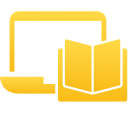
Flexible for Any Environment

Digital and Print Options

Available in English and Spanish

45-, 90- and 180-Day Pacing Guides

Dedicated Support

Curriculum Support and Training

Professional Development

Help Center
Frequently Asked Questions
You asked, we answered. Here are some of our most frequently asked questions about Foundations in Personal Finance and Foundations in Economics and Personal Finance for high school.
-
How do I get a quote?
-
Simply fill out the form above and our team will reach out. You can then request a quote and our team will provide you with one based on your class size and student needs.
-
Does Foundations meet Florida state standards?
-
Yes, our Foundations curricula are adopted by the Florida Department of Education and meet the Florida state standards. Our Foundations in Personal Finance 2024 Florida Version is adopted under Florida’s Personal Finance and Money Management course for standard and honors classes. And our Foundations in Economics and Personal Finance 2024 Florida Version is adopted for Florida’s Economics and Personal Finance course for standard and honors classes. Plus, each includes built-in content for Florida resiliency standards.
-
Does Foundations support online/virtual learning?
-
Foundations in Personal Finance and Foundations in Economics and Personal Finance are available in fully digital options, as well as print and streaming options. No matter what delivery method you choose, a printed Teachers Guide is availabe for purchase.
-
Can Foundations be translated to other languages?
-
Yes! Foundations in Personal Finance and Foundations in Economics and Personal Finance include Spanish closed captions and transcriptions for all videos, downloadable student textbook PDFs, student activities and chapter assessments in PDFs, and parent resources. Our digital platform works with popular web browser plugins like Google Translate to help other non-English speaking students translate text and read content aloud in languages like Haitian, Haitian Creole, Portuguese and many more.
-
Does Foundations support differentiated learning?
-
Yes! We have extended learning prompts specifically for differentiated learning in the Teacher Guide.
-
How long does it take to teach Foundations?
-
Foundations is designed as a semester-long course with stand-alone chapters. We provide you with flexible pacing guides that you can choose from, but if you don’t need a full semester course, the stand-alone chapters allow you to make the course fit your schedule—not the other way around.
-
How many schools have used Foundations?
-
More than 45% of schools across the country have used the Foundations curriculum. This means more than 7 million students have learned how to budget, save, spend wisely and invest. It’s a generation equipped to live out their dreams and give to the world around them.

Explore at your own pace with a video tour!
Take a closer look at our lessons and activities.

Explore at your own pace with a video tour!
Take a closer look at our lessons and activities.




